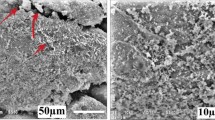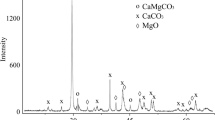Abstract
Single and binary titanium and silicon xerogels were prepared to evaluate and compare their sorption performance with commercial sorbents (Al2O3 and TiO2) used for the 99Mo/99mTc separation, under neutral pH and room temperature conditions. Molybdenum sorption capacities were determined by batch equilibrium systems using Mo(VI) solutions labelled with 99Mo radiotracer. Ti-xerogel showed the highest 99Mo distribution coefficient and sorption capacity, while Si-xerogel exerted null affinity. Binary xerogels and reference sorbents showed similar capacities. Additionally, Ti-xerogel, after a heating process, drastically decreased its sorption capacity. Finally, a molybdenum sorption mechanism was studied.







Similar content being viewed by others
References
Rathmann SM, Ahmad Z, Slikboer S et al (2019) The Radiopharmaceutical Chemistry of Technetium-99m. Radiopharmaceutical Chemistry. Springer International Publishing, Cham, pp 311–333
Osso JA, Catanoso MF, Barrio G et al (2012) Technetium-99m New Production and Processing Strategies to Provide Adequate Levels for SPECT Imaging. Curr Radiopharm 5:178–186. https://doi.org/10.2174/1874471011205030178
IAEA (2013) Non-HEU Production Technologies for Molybdenum-99 and Technetium-99m. IAEA, Vienna
Ruth TJ (2020) The Shortage of Technetium-99m and Possible Solutions. Annu Rev Nucl Part Sci 70:77–94. https://doi.org/10.1146/annurev-nucl-032020-021829
Hasan S, Prelas MA (2020) Molybdenum-99 production pathways and the sorbents for 99Mo/99mTc generator systems using (n, γ) 99Mo: a review. SN Appl Sci 2:1782. https://doi.org/10.1007/s42452-020-03524-1
Aydia MI, Hiekal AS, El-Azony KM et al (2020) Preparation and characterization of poly nano-cerium chloride for 99Mo production based on neutron activation reactions. Appl Radiat Isot 163:109211. https://doi.org/10.1016/j.apradiso.2020.109211
Dash A, Knapp FF, Pillai MRA (2013) 99Mo/99mTc separation: An assessment of technology options. Nucl Med Biol 40:167–176. https://doi.org/10.1016/j.nucmedbio.2012.10.005
Bagheri S, Mohd Hir ZA, Yousefi AT, Abdul Hamid SB (2015) Progress on mesoporous titanium dioxide: Synthesis, modification and applications. Microporous Mesoporous Mater 218:206–222. https://doi.org/10.1016/j.micromeso.2015.05.028
Paris J, Dierickx T, Vanwolleghem P et al (2018) US Patent No 2018/0233243 A1 Radioisotope generator having a stationary phase comprising titanium oxide. U.S. Patent and Trademark Office, Washington, DC
Mushtaq A, Mansoor MS, Karim HMA, Khan MA (1991) Hydrated titanium dioxide as an adsorbent for99Mo−99mTc generator. J Radioanal Nucl Chem Artic 147:257–261. https://doi.org/10.1007/BF02040373
Qazi QM, Mushtaq A (2011) Preparation and evaluation of hydrous titanium oxide as a high affinity adsorbent for molybdenum (99 Mo) and its potential for use in 99m Tc generators. Radiochim Acta 99:231–235. https://doi.org/10.1524/ract.2011.1817
Chakravarty R, Shukla R, Gandhi S et al (2008) Polymer embedded nanocrystalline titania sorbent for 99Mo- 99mTc generator. J Nanosci Nanotechnol 8:4447–4452. https://doi.org/10.1166/jnn.2008.280
Hatsukawa BY, Nagai Y, Kin T et al (2011) Isotope production for medical usage using fast neutron reactions. Isot Prod Med usage using fast neutron React 1:327–329. https://doi.org/10.1524/rcpr.2011.0057
Owoeye SS, Jegede FI, Borisade SG (2020) Preparation and characterization of nano-sized silica xerogel particles using sodium silicate solution extracted from waste container glasses. Mater Chem Phys 248:122915. https://doi.org/10.1016/j.matchemphys.2020.122915
Guzel Kaya G, Deveci H (2020) Synergistic effects of silica aerogels/xerogels on properties of polymer composites: A review. J Ind Eng Chem 89:13–27. https://doi.org/10.1016/j.jiec.2020.05.019
Chattopadhyay S, Saha Das S, Barua L et al (2019) A compact solvent extraction based 99Mo/99 mTc generator for hospital radiopharmacy. Appl Radiat Isot 143:41–46. https://doi.org/10.1016/j.apradiso.2018.10.017
Zeidman AB, Rodriguez-Narvaez OM, Moon J, Bandala ER (2020) Removal of antibiotics in aqueous phase using silica-based immobilized nanomaterials: A review. Environ Technol Innov 20:101030. https://doi.org/10.1016/j.eti.2020.101030
Saptiama I, Kaneti YV, Suzuki Y et al (2017) Mesoporous alumina as an effective adsorbent for molybdenum (Mo) toward instant production of radioisotope for medical use. Bull Chem Soc Jpn 90:1174–1179. https://doi.org/10.1246/bcsj.20170184
Mariscal R, Rojas S, Gómez-Cortés A et al (2002) Support effects in Pt/TiO2–ZrO2 catalysts for NO reduction with CH4. Catal Today 75:385–391. https://doi.org/10.1016/S0920-5861(02)00087-1
Pérez-Hernández R, Gómez-Cortés A, Arenas-Alatorre J et al (2005) SCR of NO by CH4 on Pt/ZrO2–TiO2 sol–gel catalysts. Catal Today 107–108:149–156. https://doi.org/10.1016/j.cattod.2005.07.080
Goldberg S (1993) Constant Capacitance Model. 278–307
Badillo-Almaraz VE, López-Reyes C, Soriano-Rodríguez JM (2018) Equilibrium studies and modeling on the removal of 56Mn(II) by alumina and kaolinite. J Radioanal Nucl Chem 316:571–578. https://doi.org/10.1007/s10967-018-5823-3
Baes CF, Mesmer RS (1976) The Hydrolysis of Cations. Wiley-Interscience, New York, United States
Zhu W, Yang H, Xie Y et al (2016) Hierarchically porous titania xerogel monoliths: Synthesis, characterization and electrochemical properties. Mater Res Bull 73:48–55. https://doi.org/10.1016/j.materresbull.2015.08.025
Sing KSW, Everett DH, Haul RAW et al (1985) Reporting physisorption data for gas/solid systems with special reference to the determination of surface area and porosity (Recommendations 1984). Pure Appl Chem 57:603–619. https://doi.org/10.1351/pac198557040603
Dash A, Chakravarty R (2014) Pivotal role of separation chemistry in the development of radionuclide generators to meet clinical demands. RSC Adv 4:42779–42803. https://doi.org/10.1039/c4ra07218a
Dash A, Chakravarty R, Ram R et al (2012) Development of a 99Mo/99mTc generator using alumina microspheres for industrial radiotracer applications. Appl Radiat Isot 70:51–58. https://doi.org/10.1016/j.apradiso.2011.07.012
Metwally SS, Attallah MF (2019) Impact of surface modification of chabazite on the sorption of iodine and molybdenum radioisotopes from liquid phase. J Mol Liq 290:111237. https://doi.org/10.1016/j.molliq.2019.111237
Fallah N, Taghizadeh M, Hassanpour S (2018) Selective adsorption of Mo(VI) ions from aqueous solution using a surface-grafted Mo(VI) ion imprinted polymer. Polymer (Guildf) 144:80–91. https://doi.org/10.1016/j.polymer.2018.04.043
Chakravarty R, Bahadur J, Lohar S et al (2019) Solid state synthesis of mesoporous alumina: A viable strategy for preparation of an advanced nanosorbent for 99Mo/99mTc generator technology. Microporous Mesoporous Mater 287:271–279. https://doi.org/10.1016/j.micromeso.2019.06.020
Korde A, Mallia M, Shinto A et al (2014) Improved kit formulation for preparation of 99mTc-HYNIC-TOC: Results of preliminary clinical evaluation in imaging patients with neuroendocrine tumors. Cancer Biother Radiopharm 29:387–394. https://doi.org/10.1089/cbr.2014.1657
Chen YC, Lu C (2014) Kinetics, thermodynamics and regeneration of molybdenum adsorption in aqueous solutions with NaOCl-oxidized multiwalled carbon nanotubes. J Ind Eng Chem 20:2521–2527. https://doi.org/10.1016/j.jiec.2013.10.035
Orrego P, Hernández J, Reyes A (2019) Uranium and molybdenum recovery from copper leaching solutions using ion exchange. Hydrometallurgy 184:116–122. https://doi.org/10.1016/j.hydromet.2018.12.021
Denkova AG, Terpstra BE, Steinbach OM et al (2013) Adsorption of Molybdenum on Mesoporous Aluminum Oxides for Potential Application in Nuclear Medicine. Sep Sci Technol 48:1331–1338. https://doi.org/10.1080/01496395.2012.736443
Hamed MM, Rizk HE, Ahmed IM (2018) Adsorption behavior of zirconium and molybdenum from nitric acid medium using low-cost adsorbent. J Mol Liq 249:361–370. https://doi.org/10.1016/j.molliq.2017.11.049
Brion-Roby R, Gagnon J, Nosrati S et al (2018) Adsorption and desorption of molybdenum(VI) in contaminated water using a chitosan sorbent. J Water Process Eng 23:13–19. https://doi.org/10.1016/j.jwpe.2018.02.016
Attallah MF, Youssef MA, Imam DM (2020) Preparation of novel nano composite materials from biomass waste and their sorptive characteristics for certain radionuclides. Radiochim Acta 108:137–149. https://doi.org/10.1515/ract-2019-3108
Hamed MM, Ahmed IM, Holiel M (2019) Retention behavior of anionic radionuclides using metal hydroxide sludge. Radiochim Acta. https://doi.org/10.1515/ract-2019-0010
Lian J, Zhou F, Chen B et al (2020) Enhanced adsorption of molybdenum(VI) onto drinking water treatment residues modified by thermal treatment and acid activation. J Clean Prod 244:118719. https://doi.org/10.1016/j.jclepro.2019.118719
Moret JLTM, Alkemade J, Upcraft TM et al (2020) The application of atomic layer deposition in the production of sorbents for 99Mo/99mTc generator. Appl Radiat Isot 164:109266. https://doi.org/10.1016/j.apradiso.2020.109266
Wang X, Gan Y, Guo S et al (2018) Advantages of titanium xerogel over titanium tetrachloride and polytitanium tetrachloride in coagulation: A mechanism analysis. Water Res 132:350–360. https://doi.org/10.1016/j.watres.2017.12.081
Puigdomenech I (2016) MEDUSA (Make Equilibrium Diagrams Using Sophisticated Algorithms)-Hydra chemical equilibrium software
Acknowledgements
Authors are thankful to Juan Vidal for conducting radiochemical measurements and also to the Reactor Department personnel (ININ) for their assistance in the radionuclide production. Moreno-Gil would like to acknowledge the scholarship received from the Mexican National Council of Science and Technology (CONACyT-Mexico).
Author information
Authors and Affiliations
Corresponding author
Ethics declarations
Conflict of interest
The authors have no conflicts of interest to declare that are relevant to the content of this article.
Additional information
Publisher's Note
Springer Nature remains neutral with regard to jurisdictional claims in published maps and institutional affiliations.
Rights and permissions
About this article
Cite this article
Moreno-Gil, N., Badillo-Almaraz, V.E., Pérez-Hernández, R. et al. Comparison of the sorption behavior of 99Mo by Ti-, Si-, Ti-Si-xerogels and commercial sorbents. J Radioanal Nucl Chem 328, 679–690 (2021). https://doi.org/10.1007/s10967-021-07663-6
Received:
Accepted:
Published:
Issue Date:
DOI: https://doi.org/10.1007/s10967-021-07663-6




